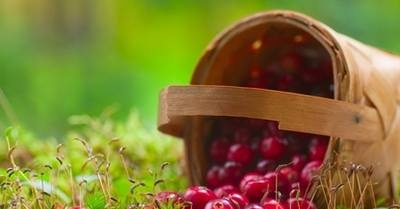|
 For a long time, the Slavs collected cranberries as a medicinal plant that helps with high temperatures, fever, cough, scurvy, treated wounds and festering ulcers with juice. A cranberry tonic drink was widely used as a substitute for tea in ancient Russia. The cranberry was well known in Ancient Rome, among the peoples of the North, wherever there were wetlands. For a long time, the Slavs collected cranberries as a medicinal plant that helps with high temperatures, fever, cough, scurvy, treated wounds and festering ulcers with juice. A cranberry tonic drink was widely used as a substitute for tea in ancient Russia. The cranberry was well known in Ancient Rome, among the peoples of the North, wherever there were wetlands.
Marsh cranberry (Oxycoccus (sour, spherical) quadripetalus Gilib) is an evergreen four-petalled plant of the cowberry family. It is a small, lodging shrub with dark green leathery leaves and bright red berries. It grows in peat and sphagnum bogs, forming a continuous carpet and sometimes occupying huge areas. The flowering period is from May to June. The berries ripen by early autumn. Harvested in autumn or spring. Autumn berries contain less active substances and mineral salts and are less well stored.
In North America, the crane berry grows - a pea-sized cranberry, named from the ovary of berries that resemble the head of a crane with a long beak. Since the beginning of the nineteenth century, it has been successfully cultivated in many states. American cranberries were used as the best remedy for scurvy and exported to Europe. It is used to make turkey sauce, which is why it received the status of the national berry of the United States.
 In terms of the content of substances useful to humans, it belongs to the gifts of nature, which in the highest degree have healing qualities. Potassium, magnesium and calcium, copper and silver, lead and iron, iodine and manganese, vitamins B2, B1, C, PP, K, flavonoids, glycosides, fructose, glucose, triterpene acids, phytoncides, tannins, pectin substances - this is an incomplete list components that make up one berry. The spring cranberries are especially rich in chemical composition. Due to the content of benzoic acid, it is stored for a long time without the use of heat treatment and preservatives. In terms of the content of substances useful to humans, it belongs to the gifts of nature, which in the highest degree have healing qualities. Potassium, magnesium and calcium, copper and silver, lead and iron, iodine and manganese, vitamins B2, B1, C, PP, K, flavonoids, glycosides, fructose, glucose, triterpene acids, phytoncides, tannins, pectin substances - this is an incomplete list components that make up one berry. The spring cranberries are especially rich in chemical composition. Due to the content of benzoic acid, it is stored for a long time without the use of heat treatment and preservatives.
Contrary to popular belief that cranberry harvesting takes place before the first frost according to the traditions of ancient peoples, this berry should be picked after frost or in spring. Collected in early autumn, it is poorly stored and turns black. Cranberries with white barrels are kept without removing debris for a couple of weeks in containers with good air permeability (grass bags, birch bark boxes) until they turn red. Then it is subjected to cleaning by rolling on an inclined surface with limiting sides. Unripe (white) berries deteriorate after rolling. Nowadays, cranberries are usually frozen.
It promotes digestion, is good for the kidneys, induces appetite, kills germs, and fights inflammatory processes in the body.
From sweet-sour cranberries, juices, syrups, soft drinks are prepared, preserves, jams, jelly are cooked. It is added to sauerkraut, cereals and other vitamin-rich dishes. It is useful to use cranberries with meat dishes, mushrooms and other hard-to-digest foods. There are many recipes for making alcoholic cranberry tinctures. Cranberry vodka is known all over the world. The healing properties of cranberries are used in the manufacture of medicines.
Aleksakhin O. A.
|